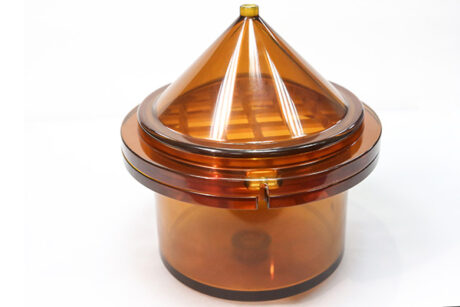Project Case of Custom Plastic Experimental Container Processed by CNC
I. Project Background
A scientific research institution is conducting a chemical experiment sensitive to light and needs to customize a special experimental container. The container needs to have a specific conical top cover structure to achieve precise light control of the internal experimental environment. At the same time, the main body of the container should be able to stably hold experimental reagents, and there should be a good sealing performance between various components to prevent reagent leakage or external light interference. The traditional mold manufacturing method has problems such as long mold development cycle and high cost for such small-batch, high-precision and specially structured experimental containers, which cannot quickly meet the scientific research needs. Therefore, the scientific research institution cooperated with Dongguan Jili Technology to customize the plastic experimental container by using CNC machining technology.
II. Processing Difficulties
- Material Property Challenges: The selected amber light-transmitting plastic (PC material) has a certain toughness. During the CNC machining process, problems such as fast tool wear, material deformation, and rough surface are prone to occur, which affect the precision and appearance quality of the container.
- Complex Structure Machining: The conical top cover of the container has a special grid-like internal structure. The mating surface between the main body and the top cover requires extremely high precision to ensure sealing performance. At the same time, the overall dimensional tolerance of the container needs to be controlled within ±0.02mm, and traditional machining processes are difficult to accurately achieve such a complex and high-precision structure.
- Assembly Precision Control of Multiple Components: The container is composed of multiple components such as the top cover, main body, and sealing ring. The assembly between each component requires strict dimensional matching. Any machining error of one component may lead to the failure of the overall assembly, affecting the sealing performance and service performance of the container.
III. Solutions from Jili Technology
- Tool and Machining Parameter Optimization: Aiming at the characteristics of PC plastic, special cemented carbide coated tools are selected to reduce the adhesion between the tool and the material. At the same time, the cutting speed, feed rate, cutting depth and other parameters of CNC machining are optimized, and a high-speed and small cutting depth machining method is adopted to reduce the risk of material deformation and improve the machining surface quality.
- High-Precision Programming and Machining: Professional CAD/CAM software is used to perform 3D modeling and programming for the complex structure of the container to ensure the accuracy of the machining path. During the machining process, a five-axis 联动 CNC equipment is used to realize the high-precision machining of the conical top cover grid structure and complex mating surfaces, and strictly control the dimensional tolerance of each part.
- Assembly Precision Control: After each component is machined, strict dimensional inspection is carried out, and high-precision inspection equipment such as a coordinate measuring machine is used to ensure that the size of each component meets the design requirements. Then, pre-assembly debugging is carried out to adjust the existing small errors in time to ensure that each component has good sealing performance after assembly and the overall performance meets the standards.
IV. Project Achievements
The plastic experimental container customized by CNC machining (as shown in the photo) perfectly meets the needs of the scientific research institution. The dimensional accuracy of the container is controlled within ±0.01mm, each component fits closely, and the sealing performance is good, effectively preventing reagent leakage and external light interference. The surface of the container made of PC material is smooth, without obvious machining marks, and the light transmittance meets the light control requirements of the experiment. This project not only provides precise tools for scientific research experiments, but also greatly shortens the production cycle, from several weeks of traditional mold manufacturing to about one week, and reduces costs, which has been highly recognized by scientific research institutions, fully demonstrating the advantages of CNC machining in small-batch and high-precision plastic part customization.

